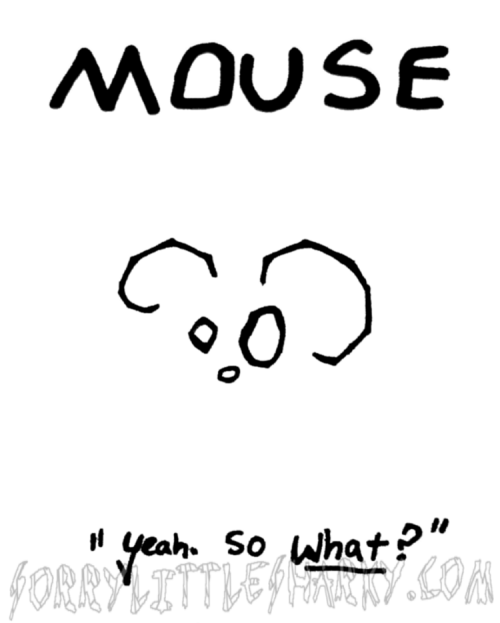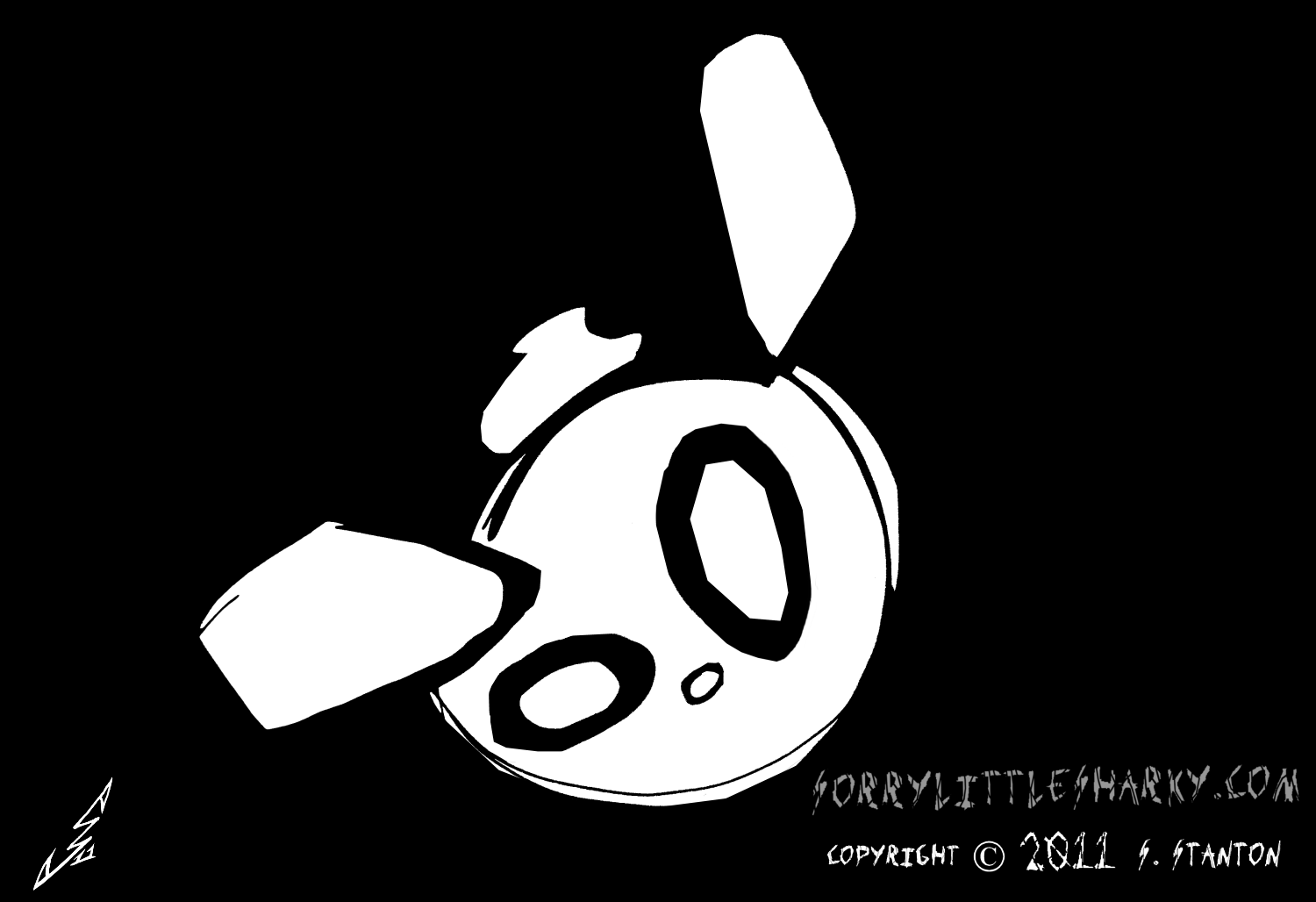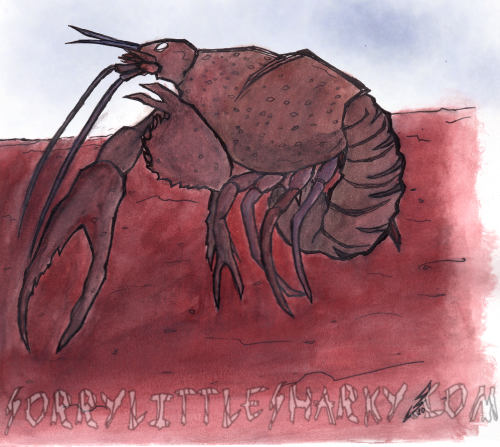The common perception of art that has been challenged time and again is that it has to be deep and full of meaning, construed in an understandable framework and putting substance over style.
An artist’s self-expression, while prone to being misinterpreted on the way (another article) may set itself up to adhere to this, but then again, it also may not, because the work of art is at the artist’s discretion, and since it is he or she who is making it, her or his rule is law. Both sides of this hold true in contemporary art especially. In the subject of this article, we observe a perfect example of shallow (and at times anti-) art, as made by S. Shultz. One caveat, however, is that the word “shallow,” in this context, is a compliment.
One Day, A Thing Happened…
The style of SorryLittleSharky is anachronistic. The line-art is usually exceptionally simple, the miscellaneous works section full of short, simple one-off bursts, and the comics (outlined below in their own sections) usually employ exceptionally simple character designs. The most preferred character type exhibited is decidedly circular, or at least suggestive of roundness, and faces, when drawn, are brought down to their simplest possible form. In fact, the fact that “shallow art” is applicable to the works in question in terms of visuals because of this: the forefront of the works available often resemble as if they have been scanned from sketchbooks, without any refinement or sophistication whatsoever. This may appear on paper as a bad thing, but there are several elements to the art involved that negate this supposed shortcoming.
The first thing is that when the story requires it, SorryLittleSharky is able to draw (again) rather simple yet compelling backgrounds. More picturesque backgrounds often clash with the simpler forms of objects or characters in the foreground, often creating a surreal air by this contrast. A second feature is that often, the characters pushed forth and/or that simply, idly exist, are at odds with their singular panel, their creator, the entire concept of themselves or their situation. It is not uncommon to have the focus of a one-shot, or something like Jink-Spoodily (see below) react tersely against the narration of his own story, or to even, at times, object to its own conceptualization. The clearest example of this is “Mouse” – a single panel depicting the barest hint of a mouse, and the bare-mouse itself proceeds to ask, “Yeah, so what?” thus undercutting his own definition.
© sorrylittlesharky.com
Now let us proceed to some of Shultz’s larger concepts, mainly, her comics.
Bunnyball: A Documentary
One of the most distinctive pieces found under the roof of SorryLittleSharky is a documentary in comic form, complete with informal narrative and the transition from one aspect of the subject to the next – Discovery Channel and National Geographic documentaries follow much the same structure. The documentary focuses on a planet “comfortably far from our own reality” which is mainly populated by creatures known as bunnyballs – ball-shaped, colorful creatures with bunny ears and fluffy tails.
“Bunnyball” is an experiment in genre alchemy. On one hand, there is little actual movement in the panels, which appear more like snapshots of bunnyballs in their natural habitat, perspective angled accordingly. At least one half of every individual page is dedicated to the narration outlining the environment and behavior of bunnyballs. To that end, the world of bunnyballs is outlined with its various facets: what bunnyballs do, how they behave, what is the societal structure of bunnyballs, who are their predators (stalkers – bipedal butcher’s knives), how do they reproduce (through a staring contest, not unlike humans), how they die (they lose two staring contests in their lifetime…) In short, “Bunnyball” is everything a documentary should include if it focuses on a creature, except the creature and the surrounding environment are both mind-numbingly fictional, yet elaborately detailed in this case… and there are bees.
© sorrylittlesharky.com
MisterGuy
“MisterGuy” is a series of bait-and-switch exercises, set to the tune of random yet somehow extremely sensical. It begins with MisterGuy, the titular character, preparing to throw a party – he has everything he needs, except for some friends who are not dead, setting the erratic tone of the rest of the comic.
Following the non-party, MisterGuy ventures out at 5 in the morning to a park to ponder melancholically about his loneliness, touching on his fear of making new friends as his friends have a tendency to get hit by trucks. He quickly descends into self-pity / self-loathing, at which point a candy ball with wings dares contradict him, earning a scolding for hijacking his speech box, and a slap for good measure, which leads to the candy ball (unsurprisingly) being hit by a truck.
After a painting venture gone awry (since he is only able to use black, as per the black-and-white comic strip) MisterGuy returns home and sleeps with the feeling / foreshadowing that something bad will happen. True to his premonition, he opens his eyes one morning to a man wielding a knife, who honestly states that his intent is to kill MisterGuy – but the killer hasn’t taken into account the fact that it’s a sunny, wonderful day out and thus the mood is all wrong for killing. Instead of being stabbed, MisterGuy offers his killer a drink and listens to his problems. However, MisterGuy has actually drugged his would-be-killer’s tea, and when he passes out, hands him to the police, who apparently have been trying to catch the guy for weeks. However, MisterGuy apparently comes to the realization that the only thing closes to a friend he had was some random guy who, on a whim, came to kill him, that he handed to the authorities, which prompts him to get back and inside and start drinking. Of course, his story was a cautionary tale for you, the reader, to drink responsibly and to “drug those who would seek to use you” (to satisfy their own, random, murderous urges.)
In short, MisterGuy is a PSA at the end of “Much Ado About Nothing” if Shakespeare wrote about stick figures suffering existential crises (whether they are protagonist or killer.)
The Story of Jink-Spoodily
“The Story of Jink-Spoodily” is an exercise in contrast and narration-reality dichotomy. Falling between the cracks of the gap between observation and truth (outside and inside perception) it is basically Jink-Spoodily’s decrepit, bleak and depressing life told through a hopeful, optimistic and overall fantasy-based narration. While the narrator (never hidden that it is indeed the artist herself) paints Jink-Spoodily’s life in a soaring, uplifting manner, the visuals and Jink-Spoodily himself constantly clash with this – something that the character under observation reacts to with annoyance. Jink-Spoodily, apropos, seems to be able to see or hear the narration itself, and attempts to correct the narrator whenever she goes wildly off-base. For instance, the narration, very early on, states that Jink-Spoodily is “happily married, a great example to his children and an exemplary neighbor” to which Jink-Spoodily reveals that he lives “in a dilapidated shack deep in the heart of a festering Crack Town” and that “his neighbors tried to kill him 8 times in the past 2 days.”
This gap is somewhat demolished, however, when Jink-Spoodily catches the narrator struggling to outline how nice he is, and uses the gap to rebel against his creator. Jink-Spoodily doesn’t just leave, however, he proceeds to riff on the narrator by listing (albeit as weapons) the reasons why the narrator constantly chooses to enforce the shinier, bettered, less bleak version of reality, essentially arguing his creator into submission. The contrast, again, is clear as the creation exerts more control over what is created than the creator herself, reflecting that he is more grounded in reality than his creator.
…And Then Some Stuff
Some of Schultz’s one-offs and miscellaneous one-shot work consists by and large of set-up and subversion as opposed to set-up and payoff. For instance, one one-shot panel reads “Phantom Snail Bob” which depicts a vaguely snail-like (more worm-like) creature. The set-up is that Bob is a “phantom snail.” The subversion is when Bob’s speech bubble reads: “Ma, they’re callin’ me names again!!” thus objecting to the drawing itself. Or, in “Message –to you- from Pig” a Pig’s head elaborates on the classical image of a pig’s head and how it won’t be confused with another animal, because our minds are locked into that perception – the title notwithstanding. Another example is “Fish”, which depicts an actual, regular fish who demands to know if the reader has a problem with the fact that it is, indeed, a fish.
© sorrylittlesharky.com
But the ultimate subversion and the ultimate anti-art comes in the form of the aptly-titled “A Comic” which is an exercise in a self-aware kind of “And Plot” (note) where the end result is definitely not a comic, but instead a sum-of-its-parts, and each part (including an intermission consisting of a kid eating candy) contributing very little. There is very little in terms of plot, plot progression, there are no characters, there are barely “events” and as such, it is an anti-comic, in the format of a comic. A work similar to both “A Comic” and “Bunnyball” is a single-page Snoopy (from Peanuts) parody by the title of “Loopy: The Manically Depressed Dog” outlining the basic existence of Loopy, torn between sleeping off his depressive episodes or engaging in self-mutilation.
All-in-all, the works of Schultz offer something different. There are many alternative comics and/or graphic novels that are pushing the envelope for what art can or should be. In that area, SorryLittleSharky offers a wholly different approach, one that sees mostly from the subversive art pieces that Slave Labor Graphics is infamous for publishing. With a unique style and approach, SorryLittleSharky is well worth a looks, and a few rolling of the eyes and more than a few smiles.
Note: Defined by the Turkey City Lexicon, “And Plot” is when this happens, then that happens, then something else happens, and it all adds up to/culminates in nothing in particular.
http://www.sorrylittlesharky.com/







